Exactly 100 hundred years ago from today, on the 25 November 1915, Einstein published a paper entitled The field equations of gravitation. This paper was responsible for introducing his field theories in the form of General Relativity. Since its conception, Einstein’s General Theory of Relativity has been excruciatingly tested for flaws – of which none have come to fruition. The theory has passed every single test which has been thrown at it. But it is not completely out of the woods yet, for their is one last prediction General Relativity makes which has evaded for decades – gravitational waves.
To celebrate the centenary of advancements Einstein’s greatest theory has offered, I will take you through a brief history of how it all started as well as some of the aches and pains plaguing the theory, some of which perplexed even Einstein himself.
— Special Relativity–
During Einstein’s free time working at the Swiss patent office, he was able to daydream about what it would be like to ride alongside a light beam. Einstein’s thought experiments led to his 1905 ‘miracle year’, where he would go on to publish 4 amazing papers. Amongst proving that light exists as a particle (the photon), providing clear evidence for the existence of atoms through Brownian motion, as well as a paper on his most famous equation E = mc2, Einstein postulated a very radical theory – a theory known as the Special Theory of Relativity.
The notion of relativity has been explored since the times of Galileo. Before Einstein transformed the landscape, Newton and Galileo before him had proposed a common sense view of space and time. That was, that time was absolute and separate from space. This means that an event which takes place at a particular time, say the turning on of a light bulb inside a moving train, occurs at the same time for a person observing the light bulb who is on the train as well as for a person who is on the platform watching the train power by.
Einstein’s little thought experiment however shook this idea to its very core. If the train were to (hypothetically) be moving at the speed of light, then something very strange would happen. Ask yourself, if you were on a train moving at the speed of light and held up a mirror in front of your face, would you see your reflection?
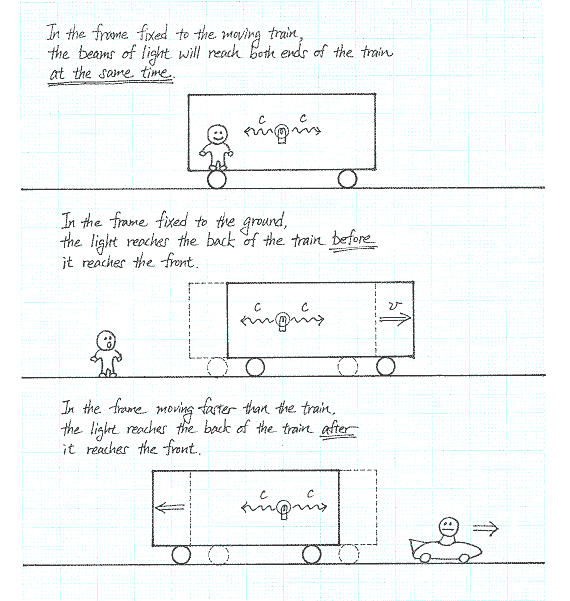
The answer is YES. This flash of inspiration came from a discovery made by James Clerk Maxwell in 1865, which was that the speed of light was constant (moving at 300,000 km/s). If the speed of light were to remain constant in any frame of reference (whether that be a stationary frame such as the man on the platform or a frame moving at some constant velocity such as that of the train passenger), then Einstein realised that the faster you move through space the slower you must move through time.
This radical idea married the ideas of time and space into a single four dimensional ‘space-time’, with the consequences involving time dilation and length contraction. This also meant that events no longer needed to happen simultaneously for observers in alternate frame of reference. One persons past could be another’s future.
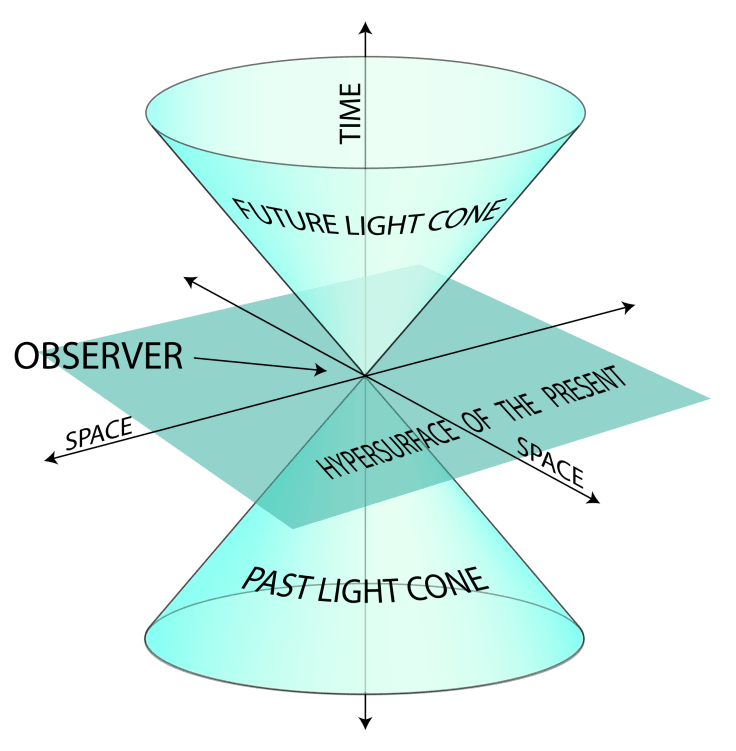
— General Relativity —

Despite Einstein’s earlier successes, he realised that Special Relativity only applied to non-accelerating frames of reference. He knew that in order to correct for this he had to incorporate gravity in – the only problem was that he didn’t know how.
“In all my life I have laboured not nearly as hard; compared with this problem, the original relativity is child’s play”. – Einstein
200 Years prior, Sir Isaac Newton had been sitting outside his lodge when he saw an apple fall from its tree. This led him to formulate his law of gravity – an objects falls towards the Earth because there exists a mysterious force pulling it down. However even Newton himself was not satisfied with this explanation – objects move because they are pushed, not because they are pulled. Einstein also knew that Newton’s theory couldn’t be right and he decided to devote the next decade of his life to solving the mystery surrounding gravity.

Einstein had no idea of where to even begin. The problem had no clear boundaries. But as always, Einstein placed his faith into his thought experiments. Sitting at his office in Bern, he began to imagine what a person would feel if they were to fall off of a roof. That is when it hit him, a flash of inspiration for the ages. If you were in an elevator at the top floor, you would feel your weight as you would normally do so on the ground. This is because gravity is pulling you towards the centre of the Earth whereas the Elevator is being held up by a series of large cables. Now if those cables were to suddenly disappear, you would have a very big problem. The elevator would not begin falling towards the ground at the same rate as you would at 9.8 m/s2. However this is where Einstein’s inspiration kicked in – as you fell with the elevator, you would be weightless! It would be as though gravity had been switched off. So what is really going on here?

The Earth has curved the space around it, and it is the space which is pushing things downwards. Not only that, but it is space-time which is curved, so that the curvature of space also means we have some warping of time. One way to visualise this is to imagine placing a bowling ball on a trampoline. In this case we can treat the bowling ball as our Sun and the trampoline as space*. The bowling ball will sink the trampoline at its location, which directly translates to the gravitational well that is produced by any sort of mass residing in the space-time continuum. Throwing a marble onto the trampoline with some velocity parallel to the sinking of the trampoline will cause it to roll around the bowling ball – in other words the Earth in orbit around the Sun.

In essence, anything with mass or energy warps space-time, creating a gravitational field.
*The catch here is that the trampoline representation is one spacial dimension smaller than our space-time reality. This means for an accurate representation you would have to imagine a bowling ball inside a three-dimensional trampoline. If you’re having trouble visualising this don’t fret, the top scientists are in the same position as you are!
— Confirming General Relativity —
Just prior to publishing his theory, Einstein used a long known problem regarding the orbit of mercury to self-check General Relativity. At that point, it had been known for quite a while that Mercury’s orbit around the Sun deviates from Newton’s Laws of Motion. Rather than having an elliptical orbit around the Sun, it tilts a little which causes it to trace out an orbit reminisce of the petals of a flower. After painstakingly calculating the orbit of Mercury using his own General Theory of Relativity, he observes a near perfect match.

The first confirmation came in 1919. One of the predictions which arose from General Theory was that a gravitational field bends passing light rays, a phenomenon known as gravitational lensing. This provided the perfect way to test his theory – light coming in from stars in a distant galaxy would be bent as it travels passed the curved space around our Sun. The problem then becomes how to see this light when the Sun produces its own blinding light via the processes of nuclear fusion. Fortunately for Einstein, this problem is solved momentarily during a total solar eclipse.

“Light only knows straight lines – what’s bent is space.” – Neil deGrasse Tyson
British Astronomer Sir Arthur Eddington succeeded in photographing the Hyades star cluster which was visible during the total solar eclipse. The relative position of the stars was compared to how they looked several months before (where they were well out of the Sun’s path) and what they observed was a bending by the amount Einstein had predicted!
It took almost half a century for the next crucial verification of Einstein’s theory. General Relativity predicted that radiation (including light) would become stretched in a gravitational field – an effect known as ‘gravitational redshift’. It was at Harvard University where physicists placed a radioactive source in the basement of a tall building with a detector on the roof. The idea was that due to the difference in gravity at the top and bottom of the building would reveal this gravitational redshift. After taking measurements, they flipped the experiment so that the source was on the roof and the detector in the basement. Just as expected, the radiation that came from the basement had a wavelength that was slightly longer than that emitted from the roof. Gravity had stretched the electromagnetic waves.

One final verification came when dealing with the time aspect of space-time. Not only was spaced altered, but time itself was also stretched in a gravitational field. This indicated that the further inside a gravitational well you are (or more simply closer to Earth’s surface), then the slower time ticks for you. This was none more apparent when engineers launched satellites for our Global Positioning System (GPS) devices to work. Initially the engineers who launched these satellites didn’t believe in the non-sense that is time dilation, yet after a couple of hours in orbit our navigations systems were offset by a number of kilometres. Luckily they were able to correct for this effect as they had taken measures ‘just in case’ Einstein was right. Seems like they should have had a little more faith in him!
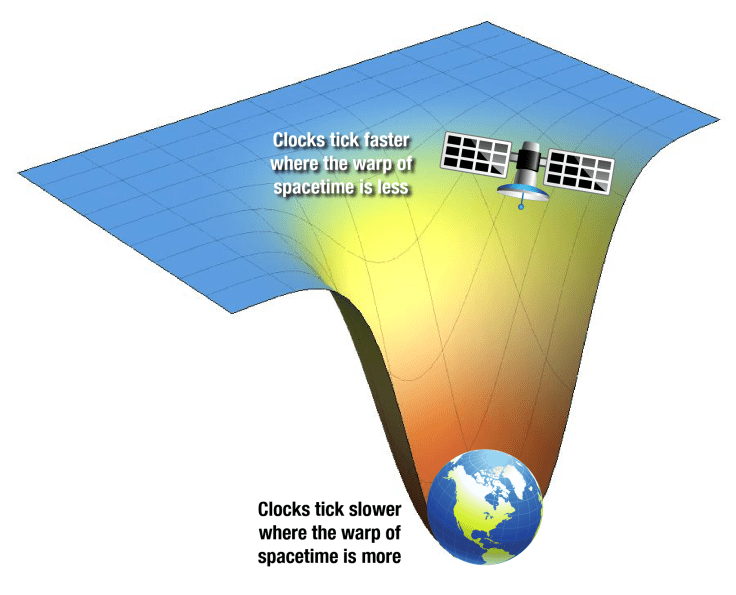
— Problems in General Relativity —
Despite all of its successes, there are still a couple of major issues surrounding General Relativity.
The last piece in completing the General theory of Relativity lies in finding gravitational waves. Einstein predicted that when any sufficiently large scale masses are accelerated then little ripples in space-time should radiate outwards. However Einstein predicted that even the most calamitous events in the cosmic realm would produce only the feeblest of waves. While we haven’t detected gravitational waves yet*, there is speculation that pulsars (rotating neutron stars) could hold the key. Except for black holes, neutron stars are the densest objects in the cosmos. The gravity on its surface would be about 1011 times the strength than what we experience here on Earth, with a teaspoon of the stuff weighing in at about a billion tonnes. If a pulsar happened to link up with an ordinary star, then in theory their oscillations should emit disturbances in the form of radioactive waves.
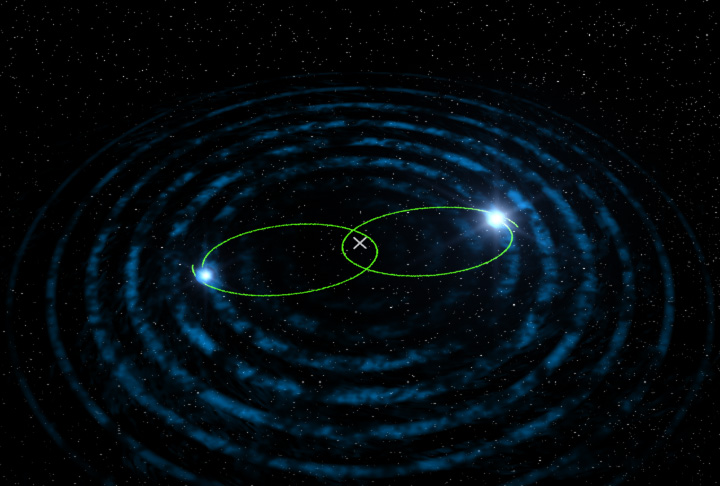
The only worry at this stage is with how to detect these tiny waves. Several detectors have been built around the world, with the most notable being the Laser Interferometer Gravitational Wave Observatory, or LIGO for short. LIGO consists of two large L shaped detectors which pick up small disturbances via a method of laser interferometry. Two sets of these detectors are crucial to verify that the source is indeed a gravitational wave and not a rogue signal, such as the rumble of a truck in the distance. As you would imagine they are extremely sensitive, with upgrades in progress to increase the sensitivity 10-fold.
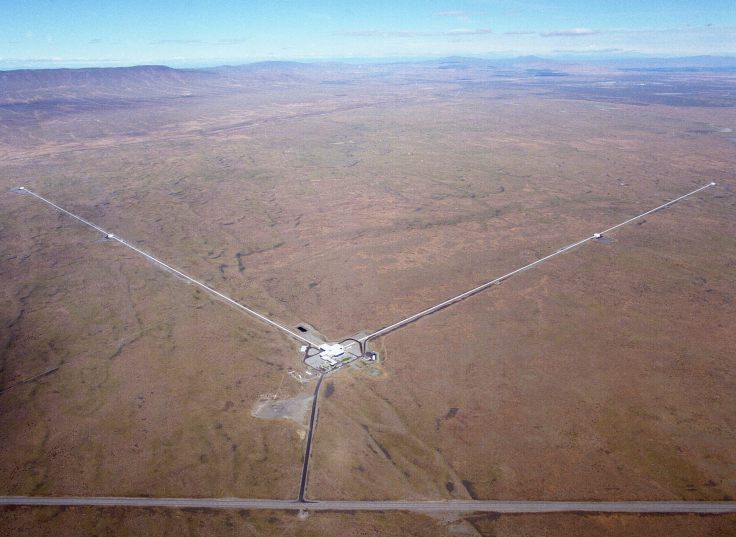
*The big stir caused by the BICEP2 data taken in the Antarctic last year turned out to be a false flag. What looked to match the expected signals for gravitational waves was actually the signals due to cosmic dust which was not accounted for, as verified by the Planck data.
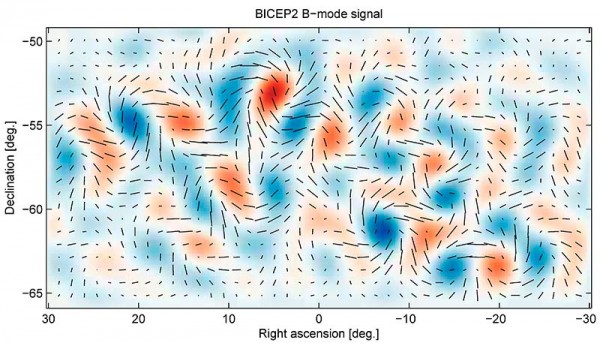
The final issue with General Relativity is its refusal to talk with Quantum Mechanics. Einstein himself wrestled with the idea of merging the two theories but was unsuccessful. Quantum mechanics basically deals with quantised energies – that is, small packets of energy in the form of photons or other ‘messenger’ particles. In order to complete the standard model of particle physics, physicists are searching far and wide for the hypothesised messenger particle of gravity – the graviton. Many believe that if the graviton is discovered, then a grand unification theory may actually be possible – something that Einstein had been working on up until his death in 1955.
— Something Extra —
One of the more exotic predictions from General Relativity was the existence of an object so dense that it curved space-time to the point where it became isolated from the rest of the universe. Black holes warp the space-time around them to such an extent that at its centre, the singularity, the equations governing space and time break down. The results which yield infinite density and time dilation indicates that the General theory of Relativity is incomplete.

If you have seen the film Interstellar then you may have some notion of what happened towards the end of the film where they went into orbit around the black hole, Gargantua. When Cooper refers to the Quantum data inside the black hole, he is specifically referring to the data that will help reconcile General Relativity with Quantum Mechanics. Additionally it explores the idea that time ticks more slowly in regions of very high gravitational fields (or more explicitly the greater warping of space-time) when they visit Miller’s planet and go into orbit around Gargantua.


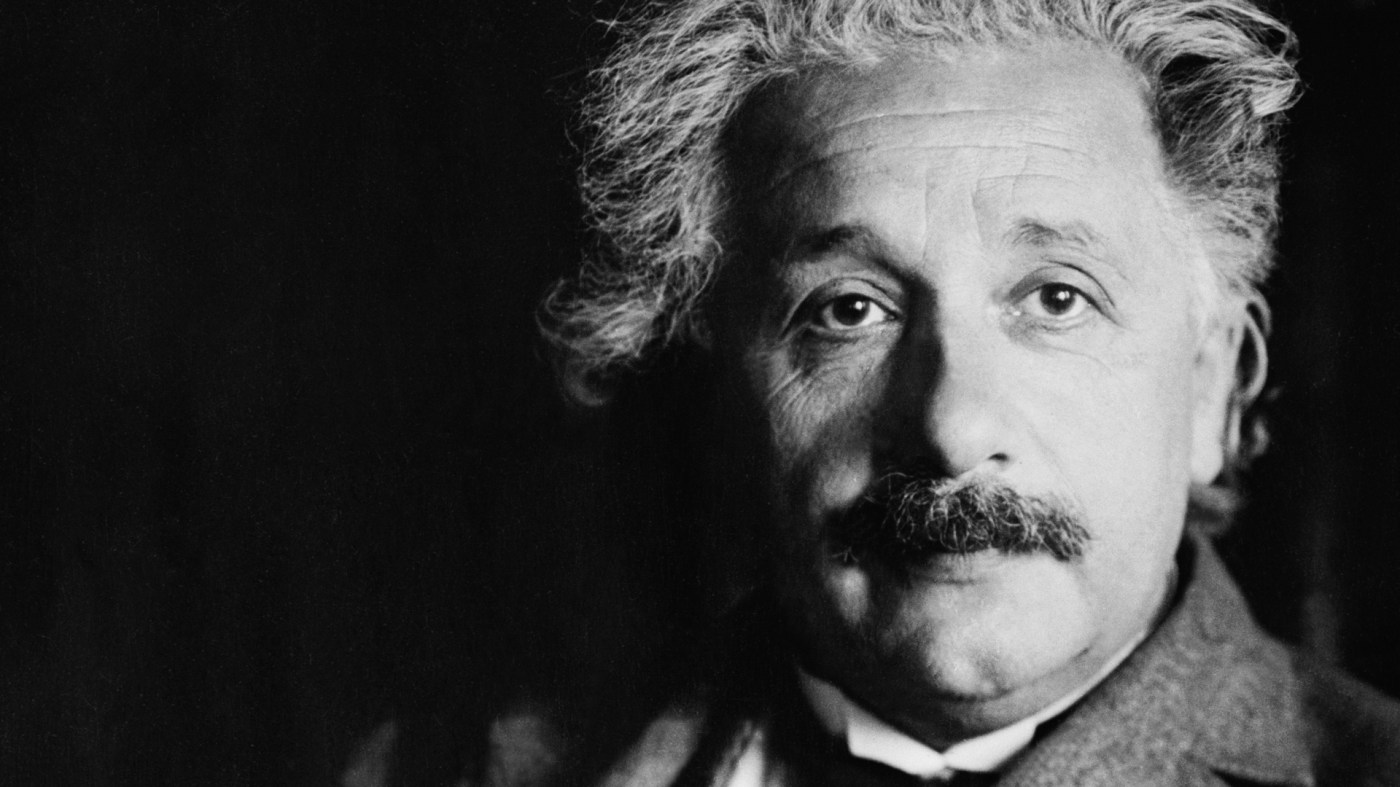

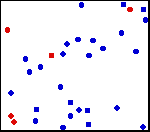

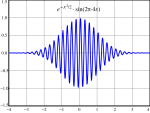
Absolute Rest Frame & Aether Frame
It would be easy to reveal the aether frame by optical means. By measuring aether drift. On the other hand, non-accelerated motion, accelerated motion (uniform linear motion and all other motions) of bodies are distinguished. And accelerating bodies show inertial forces. This is probably due to absolute rest frame. Aether frame and absolute rest frame each will probably be one and only, homogeneous, isotropic. And perhaps the two are the same frame. One thing two functions. Surprising.
LikeLike
Absolute Rest Frame
Newton’s Bucket” is a thought experiment that assumes the existence of absolute rest frame because of the rotational motion accompanied by inertial forces. Let’s take the thought experiment one step further. Inertial force must occur by “all motions except uniform linear motion” of a body with respect to absolute rest frame. Without exception. And inertial force is real existence in physics.
Note: Uniform linear motion and other motions can be superposed. And, superposition is very universal.
Absolute Rest Frame
Newton’s Bucket” is a thought experiment that assumes the existence of absolute rest frame because of the rotational motion accompanied by inertial forces. Let’s take the thought experiment one step further. Inertial force must occur by “all motions except uniform linear motion” of a body with respect to absolute rest frame. Without exception. And inertial force is real existence in physics.
Note: Uniform linear motion and other motions can be superposed. And, superposition is very universal.
Absolute Rest Frame
Newton’s Bucket” is a thought experiment that assumes the existence of absolute rest frame because of the rotational motion accompanied by inertial forces. Let’s take the thought experiment one step further. Inertial force must occur by “all motions except uniform linear motion” of a body with respect to absolute rest frame. Without exception. And inertial force is real existence in physics.
Note: Uniform linear motion and other motions can be superposed. And, superposition is very universal.
LikeLike
Absolute Rest Frame (proposal)
Accelerated motion, non-accelerated motion (uniform linear motion) and combined motions of a body all will be motions relative to absolute rest frame.
1) Uniform linear motion of a body is through.
2) Accelerated motion of a body will have corresponding inertial force.
Absolute rest frame can be easily measured (as aether drift) using light.
LikeLike
Relativity of Simultaneity
On the moon’s surface, a passenger car is moving to the right. From the point at the center of ceiling, light rays are emitted at 45 degrees downward to the left and right. So, on the floor, there are two points of light. Position of two points are symmetrical for an observer in the car and stands on the moon’s surface. This drawing should be understood by the emission theory.
LikeLike
Gravitational Acceleration (クリ)
Gravitational acceleration is a compound word. But is it worth it? About acceleration, what is special ? Nothing, will be.
LikeLike
Equivalence Principle
An elevator cabin is slowly falling due to gravity of an asteroid below. In addition, a rope is extending below the elevator cabin, and the rope is under artificial tension. Let us assume that acceleration g due to gravity (uniform acceleration) is equal to acceleration a due to tension. The equivalence principle should be forgotten.
LikeLike
Elevator Cabin and Inertial Frame
On a plane (no friction), an elevator cabin is accelerated horizontally by tension of a rope. Tension of rope is controlled so that horizontal acceleration is the same as free fall. Not only at infinite small area (local area), but also on whole area of this elevator cabin is inertial frame ?
LikeLike
Aether (repost)
All kinds of aberration are caused by motion of Earth. Qualitatively, quantitatively. For example, cycle of annual aberration is 365 days. It is reflection of motion of Earth. On the other hand, any motion of star’s side has no influence. Only position on the celestial sphere is valid. These facts will be explainable only by aether.
For an observer stationary with respect to the aether frame, there will be no aberration.
LikeLike
Local Inertial Frame (repost)
Inertial frame or non-accelerating frame, is a frame that is non-accelerating with respect to aether. So, in free-falling elevator, there is no inertial frame, even locally. Term “local inertial frame” will be nonsense.
In the elevator, equal acceleration due to falling is acting on every mass point. There are no exceptions. Even locally.
There can be composition or partial composition of inertial force and gravity. But the two are inviolable to each other. Inviolable, qualitatively and quantitatively.
LikeLike
Does Aether Exist?
Two spacecrafts are sailing from left to right in outer space. It is as far apart as Mars. Speeds are v and 2v. Two spacecraft flash at the same and long time interval. What is interval between the position of flashes on the celestial sphere as seen from the Earth ?
LikeLike
Secular aberration
This is what comes into my mind. Three aberrations; daily, annual, and secular seem to form a closed necklace drawn in one stroke. Pearl are 365 (assuming star is visible even during day time).
The star change its position at all times. Trajectory drawn on celestial sphere in one year will not be a ellipse but be an extended necklace with pearls.
LikeLike
Michelson-Morley Experiment
In a book Theory of Relativity by Pauli, W 1958, it’s written as follows (quoted from English version ; in 1-6). “Rather should one say that for an observer moving with medium, light is propagated as usual with velocity c/n in all directions”. It seems to be the “very and true explanation” for M-M experiment (done in air) !!
There is Einstein’s saying the same as above Pauli’s. Therefore, probably, he said that he didn’t know M-M experiment (and he mutters, “M-M experiment (done in air) is nonsense and I have no obligation to talk about it”).
LikeLike
About Light
In outer space, frequency and wavelength of two star lights (coming from the opposite direction) are measured (at the same time). Sum of the speed of two lights will be constant. It is 2c or close to 2c.
Above shows that in outer space, light is propagated relative to aether. And, speed of light relative to an observer is not constant.
LikeLike
Moon and Sun (Hypothesis: Restated)
Assume that sun’s light follows emission theory for a few seconds only. Matter of those on few seconds will be indistinguishable from earth. That is, sun is being in aether. So, light-time correction. And, light-time correction will be offset by secular aberration.
Assume that moon’s light follows emission theory for a few seconds only. So, visible position of moon is exactly where it is. Just like sun. But the mechanism will be different.
LikeLike
Equivalence Principle ?
A body is suspended by a string from roof of a passengercar. The same two passengercars started at the same jerk at the same time. Tension of string is increasing, and string broke at about the same time (for both person in the car and on on the ground). Inertial force and gravity will not be equivalent.
LikeLike
Equivalence Principle
Starting is to accept inertial forces as inertial forces. In a free-fall elevator, inertial force and gravity acting on the entire cabin is equal. As Newton’s third law of motion shows. Magnitudes of inertial force, gravity and others acting on each mass point in elevator are as shown by Newton. That’s all.
Eh, the equivalence principle? Will be worthless at all.
LikeLike
Inertial Force is not Fictitious
In addition to acceleration, there are jerk, snap, etc. And accordingly, inertial force must be varied. Inertial force cannot be fictitious.
There must be absolute rest frame, so there are acceleration, jerk, snap, etc. In wikipedia (Japanese), in “Acceleration”, there is a table titled “Comparison of magnitude of acceleration”. Many examples of acceleration are shown in 18 division by magnitude.
LikeLike
Inertial Force is not Fictitious
The same five bodies (mass m) are lined up sideways on a horizontal plane. Five bodies are tied with strings. Assume that horizontal plane is zero friction, and mass of strings is zero. On right most body, force of 5ma is acting and five bodies start a uniform linear accelerating motion toward the right. Tension acting on four strings are, from right to left, 4ma, 3ma, 2ma, and 1ma. For any observer.
LikeLike
Accelerated Motion is not Fictitious
A horizontally long container is filled with fluid. This container is being accelerated to the right. In the container, pressure of the fluid will be high on the left and low on the right (effect of gravity is separated question). Accelerated motion is not fictitious.
But is this worth writing down ?
LikeLike
Equivalence Principle
On a mass point, two forces of equal magnitude are acting from the left and right. Two forces are tension, gravity, and inertial force. Wnen, left and right are not distinguished, there are five possible combinations (there is no combination of inertia force and inertia force). Is the equivalence principle still insisted upon ?
LikeLike
Perihelion Shift of Mercury (an essay)
Shift is smooth, like a hand of clock. Mainly, it will be two-body problem.
LikeLike
Perihelion Shift of Mercury (an essay)
Centrifugal force is inertial force and cannot be the first cause of perihelion shift. The 99-101 effect mentioned above (tentative naming: contrary to Newton’s spherical shell theorem) will be caused by size of Mercury, size of Sun, and distance between Mercury and Sun. On Mercury, these have effect on gravity and it will be the first cause. And then, direction of elliptical orbit may be shifted. At perihelion, this effect will be greatest.
Magnitude of perihelion shift of planets with satellite is far superior. This is probably because gravity of Sun acting on satellite in half orbit close to Sun is far superior.
LikeLike
Perihelion shift of Mercury (an essay)
Another inference. Half mentioned already at end of May. Mentioned was problem posing about a single gravitational source and gravitational sources separated into two. Let’s call this effect as the 99-101 effect. The 99-101 effect is equal to the two of binary stars. The 99-101 effect is a candidate for explanation of perihelion shift of Mercury. However, it is incompatible with attempt to explain by Sun’s spherical surface. I don’t know which one is hopeful.
If gravity source is close, size of gravitational source will increase gravity. Then, Newton’s sphericl shell theorem must be reviewed.
LikeLike
Perihelion Shift of Mercury (an essay)
This is an idea. In this problem, planets seem to be treated as a point. Now, planet is divided into two hemispheres. One is closer to Sun and the other is far from Sun (back to back). If the planet is far from Sun, centrifugal force and gravity each acting on two hemispheres will be the same(1/2). But, how about Mercury? We must imagine a spherical surface that centers on Sun, and this spherical surface coincides with center of Mercury ? And then, in whole Mercury, centrifugal force will be larger and gravity will be smaller. It is compared to Mercury as a point.
Sorry, please ignore my two posts immediately preceding this one.
LikeLike
Perihelion Shift of Mercury (essay)
Mercury is revolving in orbit. Size of Mercury increases centrifugal force acting on revolving Mercury. This will be reason for perihelion shift of Mercury. The angle is about 5.75 arc-sec in a year.
Size of Mercury will also increase gravity of Sun (which acts on Mercury). But it will not affect direction of long axis of elliptical orbit (after a round: that is, it will be unrelated to perihelion problem).
LikeLike
Perihelion Shift of Mercury (an essay)
This is a guess. Because of size of Mercury (in its elliptical orbit), centrifugal force will be increased. And, as Sun is near, effect of size will be larger (other planets are more like point).
LikeLike
Perihelion Shift of Mercury (an essay)
This is a thought experiment on close binary stars (imagine on a plane no friction). Imagine the same homogeneous true sphere with mass m. Main star is three spheres and companion star is two spheres (these are attached as a single unit). These are on a straight line. Gravity exerted and affected by and to each will depend on size of true spheres (of here and there). Forget the spherical shell theorem. Two-body problem is also complicated.
LikeLike
Perihelion Shift of Mercury (an essay)
Increase in gravity due to size of Sun will depend on distance r between Sun and Mercury. This increase in gravity will be larger at perihelion and smaller at aphelion. Is this the reason for perihelion shift of Mercury ? Sorry for my repetitive posts.
LikeLike
Perihelion Shift of Mercury (correction)
Sorry, I ask to delete my post (June 9) and replace it with following.
It is said that magnitude of Sun’s gravity acting on Mercury depends on Sun’s mass m and distance r between the two. However, in reality, Sun’s size will have effect. Noticeably on Mercury, which is close to Sun. Gravity will be greater slightly. Let’s focus on orbit just after Mercury passes perihelion. Orbit will be slightly inward (r will be shorter also). This means that size of Sun shifts position of perihelion in the next around.
P.S. Orbit to be compared is orbit when Sun is a point.
LikeLike
Perihelion Shift of Mercury (Gleanings)
It is said that magnitude of Sun’s gravity acting on orbiting Mercury depends only Sun’s mass m and distance r between the two. But in reality, in addition, there will be an effect of Sun’s size. Gravity will be slightly greater. Therefore, Mercury’s orbit that has left aphelion will be slightly inward (and r will also be shorter), and then, perihelion will be shifted.
LikeLike
Perihelion Shift of Mercury (repost)
In a drawing, a fixed star F homogeneous true sphere and a planet P orbiting nearby are drawn. F acts gravity on P. Is magnitude of gravity on P dpending solely on mass m of F and distance r between FP ? No, the size of F may also have a slight effect. This will be main reason for the perihelion shift (secondary reasons are omitted). Newton’s spherical shell theorem may not be perfect.
Square of 99 is 9801. Square of 101 is 10201. See above my post.
LikeLike
Perihelion Shift of Mercury (repost)
Size of Sun relative to Mercury will be main cause of this problem (however, will be incompatible with Newton’s spherical shell theorem).
There are two drawings in which Mercury and gravity source (considered as a point) are drawn. In one drawing, gravity source is Sun and its mass is m. Distance from Mercury is 100. In the other drawing, there are two alternative gravity sources to the sun, Mass is m / 2 each. Distance from Mercury is 99 and 101(aligned on a straight line extending from Mercury). Magnitude of the gravity acting on Mercury is the latter > the former. It can be ignored on Neptune.
LikeLike
Apology, Adjacent my post “Speed of light” (on prism) was wrong. Sorry.
To admin, i thank you always for accepting of my posts (I appreciate if you erace this and that two posts).
LikeLike
Speed of light
In Wikipedia’s “Dispersion (optics)”, there is a video of dispersion. By a prism, white light is spectrally dispersed. The speed of light is different between red and violet light after dispersion (spectroscopy). It is obvious at a glance.
LikeLike
Galaxy Rotatin Curve
Is it because gravitational sources (that revolve galaxy) also extend over the disk of galaxy ? Is it because the state of inverse square law of gravity is different from that of solar system ?
LikeLike
Third Law of Motion (still pending ?)
Action and raction (of the third law) are acting at the point of action, This will be the simplest picture of equilibrium of forces. Now, we beg Newton to comment. Newton whispers that reaction of the third law can include inertial force. And that, there are other pictures of equilibrium of forces including inertial force.
Not a few books and websites say that the third law is the law of two bodies. Newton’s original text is neglected. No, third law is the law of at a point of action of force. A piller of mass m is lying on a horizontal plane (without friction). If the piller is continuously pulled to the right, it is accelerated to the right. At the right end of the piller, magnitude of action-reaction is the same ma. Also, at the other positions (points of action) of the piller, magnitude of action-reaction is the same. This is a single body (like a chain).
LikeLike
Galaxy Rotation Curve
Allow me to post an idea about the above. It is contraction of the size of galaxies. But in Wikipedia (in English), there seems to be no mention.
LikeLike
Newton’s Third Law of Motion
Does gravity always act as action? Is inertial force always reaction? It is a problem statement. As an example, there is an elevator cabin in free fall (mass is m).
LikeLike
Newton’s Third Law of Motion
As an action and reaction, there are two examples about gravity. One is normal force. The other is Inertial force in free fall. The two should be accepted qualitatively and quantitatively.
LikeLike
Reviewing the Heliocentric Theory
Motion of earth is various, such as rotation, revolution, uniform linear motion of solar system, and others. And there is aberration to each. These are reflection of motions relative to uniform isotropic aether. Qualitative and quantitative.
LikeLike
Free fall (rewrited)
A body is falling in free fall. On a horizontal plane, an observer is moving in a uniform linear motion. To the observer, the falling body draws a parabola. Every point of the body is accelerating.
An elevator is falling in free fall. Assume, that there are two sources of gravity and there is a considerable distance between the two (even when viewed from elevator). How does equivalence principle explain ?
LikeLike
Perihelion shift of Mercury
In a close binary, gravity of main star is acting on companion star. Magnitude of gravity is inversely proportional to square of distance. Therefore, if size of companion star is large, gravity that acting is somewhat larger (even if mass is the same).
Note: Here is a horizontal line. From the right, gravity of main star is acting. On the line, we see three masses. Mass of right and left is m/2 and middle is m (interval is the same). Magnitude of gravity acting will be m<m/2+m/2.
LikeLike
Perihelion shift of Mercury
Here is a close binary. A companion star approaches the main star and is passing the periastron on orbit. Actual orbit of companion star is different from orbit of mass point of it. Difference will be due mainly to size of companion star (mass distribution).
LikeLike
Perihelion shift of Mercury
5.75, 2.04, 11.45. These are observed value of perihelion shift of Mercury, Venus, and Earth (in a table of a website. Value are in arcsec/year. Table covers to Neptune). The decrease in Venus will be due to distance from the Sun, and the increase in Earth will be due to the Moon.
LikeLike
Perihelion shift of Mercury (an essay)
Scaled models of Mercury and Vulcan (of my post, April 7) are falling in free fall. Magnitude of acceleration is probably Mercury > Vulcan > mass point. At the beginning of falling, centers of gravity of three models are at the same horizontal level.
A web-site says, periastron shift are many in close binaries. This will be a two body problem.
LikeLike
Perihelion shift of Mercury
Recurring orbits seem to show that this is a two body problem.
LikeLike
Perihelion shift of Mercury
Mercury is perihelion shift and binary star is periastron shift. Two shifts are smooth and in one direction. Two each must be considered to be a two body problem.
See again that table (in 近点移動). Values are observed values. And these each will be two body problem.
LikeLike
Perihelion shift of Mercury
In Wikipedia (in Japanese version : “Apsidal precession” 近点移動), there is
a table named “Perihelion shirt of planets of solar system”. These seem to
varies greatly depending on the distance from the sun and the
presence or absence of satellites. Newcomb’s table and explanation
of relativity would be NG.
A planet called Vulcan is revolving the orbit of Mercury. Assume
that mass is the same and diameter is half to Mercury. The
gravitational force of the Sun and the centrifugal force due to the
orbital motion each would be Mercury > Vulcan > mass point.
Newcomb’s table (of perturbation values of the planets acting on Mercury) should be nonsense.
LikeLike
Perihelion shift of Mercury
In Wikipedia (in Japanese version : “Apsidal precession” 近点移動), there is
a table named “Perihelion shirt of planets of solar system”. These seem to
varies greatly depending on the distance from the sun and the
presence or absence of satellites. Newcomb’s table and explanation
of relativity would be NG.
A planet called Vulcan is revolving the orbit of Mercury. Assume
that mass is the same and diameter is half to Mercury. The
gravitational force of the Sun and the centrifugal force due to the
orbital motion each would be Mercury > Vulcan > mass point.
Newcomb’s table (of perturbation values of the planets acting on Mercury) should be nonsense.
LikeLike
Stationary aether
In outer space, an observer (in an inertial frame) is measuring light of stars. The number of stars being measured is reasonable and there is no clumping of stars on celestial sphere. What is measured is frequency and wavelength of each star’s light, i.e., speed of light. The results will reveal the existence of stationary aether.
Note: Existence of stationary aether is not in doubt due to aberration.
LikeLike